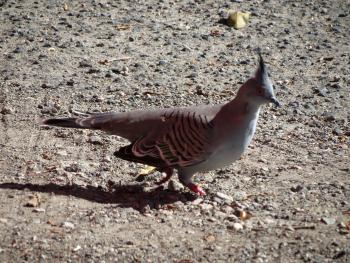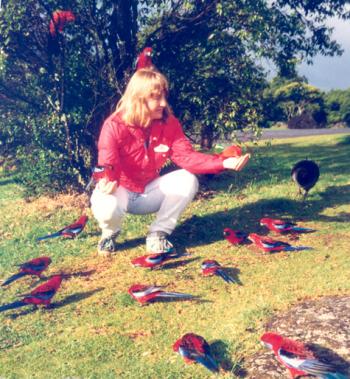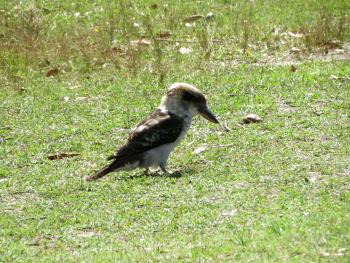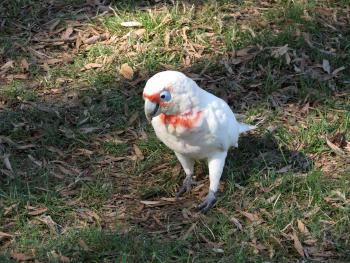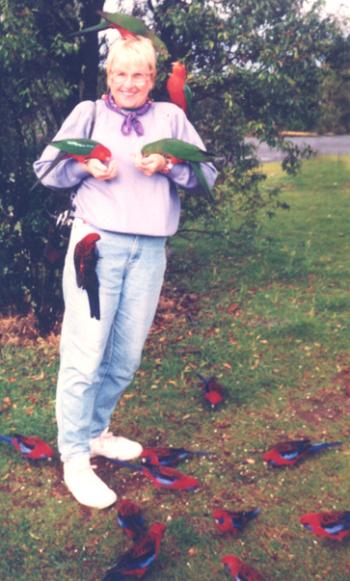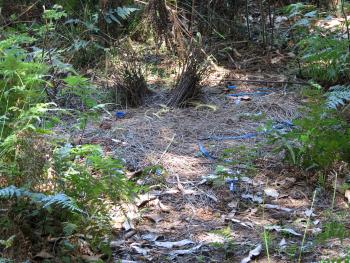A good bird-watching site (part 5)
Subscribers were invited to write in about places, outside of the US, where they've had rewarding sightings of birds. (We cannot accept more submissions.)
In addition to the types of birds they saw, we asked travelers to each tell us where they were and the year/month/time their visit took place. We also wanted to know how difficult it was to reach an area, what equipment would be recommended and what the weather was like.
We've printed responses about sites in the Americas and Africa. This month, in part 5 of the series, we're in Australia, and we'll wrap things up with other areas next month.
There is amazing bird-watching at Lamington National Park, lying on the Lamington Plateau of the McPherson Range near the Queensland/New South Wales border in AUSTRALIA.
The 20,600-hectare park is known for its rainforests, ancient trees, mountain views, waterfalls, walking tracks and birdlife.
The list of birds is long and includes regent and satin bowerbirds, green catbirds, crimson rosellas, king parrots, Lewin's honeyeaters, eastern spinebills and superb fairywrens.
I grew up in the Brisbane area and visit Lamington National Park (an hour-and-a-half drive away) at least once a year, most recently in April 2017, for bush-walking and bird-watching. There are a couple of lodges located in the park, and local experts take guests on bird-watching walks.
I enjoy planning Australia travel and am happy to answer any questions. Email me at info@travel-downunder.com.
Wendy Schatz
Bellevue, WA
An hour's drive from the Queensland Gold Coast or 1½ hours from Brisbane in Queensland, AUSTRALIA, O'Reilly's Resort (Lamington National Park Rd.; phone +61 1800 688 722, oreillys.com.au) is a must for birders of all levels.
Located within Lamington National Park, one of Australia's Gondwana rainforest UNESCO World Heritage Sites, it's a resort that specializes in bird-watching, with guided walks such as the canopy walk and unusual birds such as the bowerbird and king parrots (which will eat from your hand). There's even an evening glowworm walk.
Also, check out other accommodations in Lamington, like Binna Burra Lodge (Binna Burra Rd., Beechmont, QLD 4217, Australia; phone +61 7 5533 3747, www.binnaburralodge.com.au), for birding experiences.
When I spent a year in Brisbane in 1993, I joined an area ornithological society. During their almost-weekly outings, year-round, I was able to see the wealth of birds in Queensland.
However, for a one-stop spot, O'Reilly's is the most exciting area in which to experience a maximum-birding day (or days). I stayed there four times, once for two nights. It's worth the time to visit.
Vickie Birdsall
Scotts Valley, CA
Before a cruise that ended in Sydney, AUSTRALIA, I had arranged for a birding guide for two of our extra days there, Feb. 24-25, 2017, with Zest for Birds (phone +61 2 9639 8549, zestforbirds.com). The company offered four different day tours out of Sydney. My wife, Lisa, and I chose the two that would likely have the most variety of birds.
We were picked up at our hotel by the guide Andrew Patrick and taken south out of the city to Royal National Park, the world's second-oldest national park (after Yellowstone). On the way, Andrew pointed out a flock of king parrots that crossed the road in front of us. This would be our only sighting of that species.
We parked in a small lot at the head of a hiking/biking trail and hiked into the rainforest, where we saw quite a few species. Andrew was very skilled at identifying the birds by sight as well as by their calls. One that we heard quite often but never saw was the eastern whipbird. (Its call sounds a lot like the crack of a bullwhip.)
Taking photos was difficult because the birds were usually only seen for a few seconds before they disappeared into the dense canopy.
The next stop was at a small picnic area, where we had tea and cookies and were greeted by a laughing kookaburra, a crow-sized kingfisher (that doesn't fish).
From there, we hiked up a crude road to the top of some sandstone cliffs on the shore of the Tasman Sea. The view was breathtaking, but there weren't many birds. On the edge of the cliff, I did get some decent photos of a nankeen kestrel, and we saw some Lewin's and yellow-faced honeyeaters in the scrub along the road.
Our lunch stop was at a larger picnic area on the shore of the Hacking River, near the park's headquarters. There, Lisa noticed some blood on the bottom of my pant legs. When I lifted the pant leg, I found a fat black leech dining on my leg. I had two more wounds on my left leg and one on my right leg, and Andrew had one too.
No, we hadn't gone wading à la "African Queen"; these were terrestrial leeches we had run across in the rainforest. We peeled them off and tossed them on the ground, and Andrew got his first-aid kit.
While Lisa was dressing a bite on my left leg, two Australian magpies came up and dispatched the two leeches we had thrown on the ground. They took them in their bills and shook them vigorously several times before eating them.
Soon we were joined by a purple swamphen that was hoping for some handouts. Then the sulphur-crested cockatoos started coming in, eventually a total of six. The first one landed on the adjacent table where Andrew had put his insulated lunch bag. It started to gnaw on a corner of the bag but stopped when Andrew told it to. It didn't attempt it again.
After lunch, we hiked into the bush so Andrew could show us a satin bowerbird's bower. The bower was decorated with blue items that the male had found around the picnic area, including a bottle cap, straw, disposable razor and plastic fork. Satin bowerbirds prefer blue, but this one also had a few sulphur-crested cockatoo feathers nearby.
Near the river, we saw an azure kingfisher and a nankeen night heron. On the river were some Australasian grebes, dusky moorhens and a few Pacific black ducks.
Our last stop of the day was Centennial Park, where, despite all the people, we saw lots of birds. In fact, kids were feeding the waterfowl at the edge of the small lake.
Right as we parked, there was a crested pigeon walking around. During our walk over to a small lake, we saw both a little corella and a long-billed corella. In the trees were quite a few large fruit bats. In the lake were lots of ducks and coots plus one Australian pelican and a few black swans.
On a small island in the lake were four of the five cormorants found in Australia (Australian pied, great, little pied and little black) as well as a nesting Australasian darter with a chick.
The first day had been a very fruitful bird outing. I saw or heard 69 species, 41 of which were new to me.
•
On the second day, Lisa decided to explore the shops in Sydney, and Andrew and I headed northwest for birding, entering horse country, or, as Andrew calls them, "hobby farms." We drove down smaller and smaller lanes until we turned into Mitchell Park, one of several parks nestled in among the farms and pastures.
Over more than an hour, we saw a lot of birds there. I got some decent photos of the Oriental dollarbird, an eastern yellow robin, a sacred kingfisher and a crested shrike-tit (which I didn't know I'd seen until I studied the photos when I got home).
We then drove through Cattai National Park and were alone there except for the kangaroos. We saw several birds but not as many as at Mitchell Park.
At Cattai I photographed the olive-backed oriole and got a good photo of three maned ducks, called Australian wood ducks locally. (Local names cause headaches for international birders because sometimes when you think you've seen a new species, it turns out to be one you've already seen somewhere else but with a different common name.)
We made a couple of stops in Schelyville National Park. It was the middle of the day, and there weren't many birds about, though there were hordes of bell miners and noisy friarbirds. Bell miners sound like hundreds of monotone wind chimes.
Our next stop was the Pitt Town Nature Reserve, a freshwater lagoon sandwiched between a horse farm, Pitt Town and a golf course.
The lagoon was full of waterbirds, such as great, intermediate, little and cattle egrets; yellow-billed and royal spoonbills; straw-necked, Australian white and glossy ibises; masked lapwings; Latham's snipe, and a pair of rare freckled ducks. Soaring over the lagoon was a whistling kite and a swamp harrier.
We then drove back to Sydney and made one more stop at the parklands surrounding the site of the 2000 Sydney Olympics. A lagoon there is connected to the tidal estuary of the Parramatta River.
We went there to see one specific bird, the red-necked avocet. There were quite a few of them there, along with some white-headed stilts, masked lapwings and black-fronted dotterels.
It had been a very fruitful birding outing. I saw or heard 158 different species, 65 of which were new to me. For equipment, I had a Canon SX40 IS digital camera and Leupold 10x50 binoculars. (I have since upgraded to a Canon HS50 IS.)
The current cost for day tours with Zest for Birds is AUD330 (near $239) per day for one or two people, including lunch.
Andrew Cubbon
Marietta, GA

